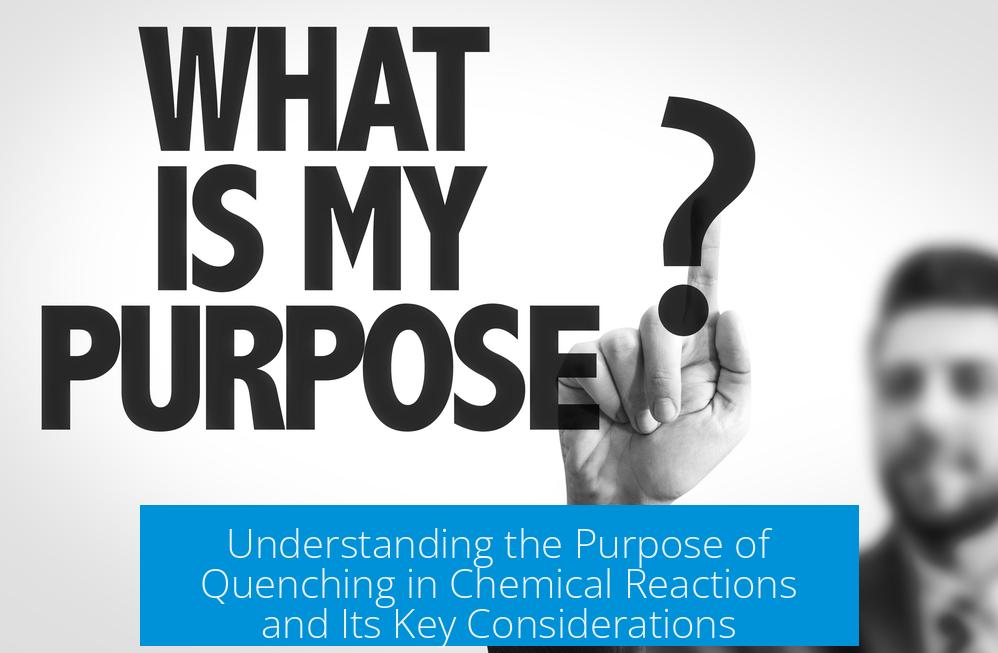The purpose of a quench is to stop ongoing chemical reactions at a specific point, converting reactive species into less hazardous forms, thereby controlling the reaction outcome and ensuring safety during the workup process. This step is crucial in organic chemistry for managing reaction progress, minimizing side products, and preventing dangerous situations such as thermal runaways or uncontrolled reactions.
Stopping the Reaction

One primary reason to quench a reaction is to halt its progress precisely. In practical terms, quenching is akin to removing a cake from the oven at just the right moment to avoid overcooking. If the reaction continues uncontrolled, it may produce unwanted by-products or degrade the desired product.
Stopping the reaction early can prevent the formation of secondary products that form at slower rates but could undermine yield and purity. For example, if molecules A and B combine to give AB mainly, prolonged reaction time could favor the formation of ABA, an undesired compound. Quenching at the optimum time preserves the selectively formed product.
Conversion of Reactive Species
Quenching also serves to convert reactive, sometimes pyrophoric, reagents into more benign chemical species. Many reagents remain dangerously reactive after the primary reaction finishes. If not quenched, excess reagent might spontaneously ignite or cause secondary reactions during handling.
This conversion helps “get rid of the excess reagent” so it neither continues unwanted reactions nor poses an ignition hazard. A common quench transforms highly reactive intermediates into stable forms that can be safely processed further.
Safety Considerations
Safety underpins much of the rationale for quenching. Some reaction mixtures contain highly reactive or thermally unstable species. If not promptly and properly quenched, these can lead to thermal runaway—a self-accelerating reaction releasing heat uncontrollably. Quenching mitigates this risk.
For example, in cases involving pyrophoric substances—compounds that ignite spontaneously on contact with air—quenching prevents dangerous ignition during workup. Proper quenching thereby protects both the chemist and the laboratory environment.
Process Control and Reproducibility

Quenching forms an integral part of controlling chemical reactions to achieve reproducible results. Chemistry reactions often involve complex competing pathways and sensitive conditions. Applying a consistent quenching step reduces variables in the reaction protocol.
This step simplifies troubleshooting and analysis by ensuring that each batch is stopped at an identical stage. It supports scale-up and quality control in industrial and academic settings.
Choice of Quenching Medium
The quenching medium, which can vary extensively, influences how the reaction is stopped and the system cooled. Common media include brine, water, polymers, oils, salts, gases, or even air. Selection depends on the reaction’s nature and desired cooling profile.
In industrial processes such as metal heat treatment, the cooling rate controlled by the quench medium affects material properties. For example, cooling rates influence metal grain structure, impacting hardness and durability. Companies specialize in producing tailored quench media to meet precise industrial needs.
Summary of Key Points
- Quenching terminates chemical reactions at a controlled point to preserve desired products and prevent side reactions.
- It converts reactive reagents into stable, less hazardous species to enable safe handling and workup.
- Quenching prevents thermal runaway and spontaneous ignition, enhancing laboratory safety.
- Routine quenching standardizes procedures, improving reproducibility and process control.
- The quenching medium selection impacts cooling rates and material outcomes, especially in industrial settings.
What is the main purpose of quenching in organic chemistry?
Quenching stops a reaction to prevent it from continuing or creating unwanted byproducts. It also converts reactive substances into safer forms before handling or workup.
How does quenching improve safety when handling reactive chemicals?
Quenching neutralizes excess reagents, preventing them from reacting further or igniting, especially important with pyrophoric materials that can catch fire on exposure to air.
Can quenching affect the selectivity of a chemical reaction?
Yes. Quenching can stop a reaction before slower side products form. This helps to maximize the desired product and minimize unwanted compounds during synthesis.
Why is quenching important for reproducibility in chemical processes?
Consistent quenching controls a key variable. By stopping reactions the same way each time, chemists reduce variability, making the process more predictable and easier to analyze.
What role does the quenching medium play in industrial settings?
The medium controls cooling rate, affecting outcomes like grain structure in metals. Options include brine, water, oil, polymer, and air, each influencing the reaction’s final properties.





Leave a Comment